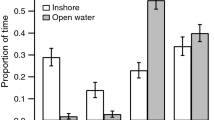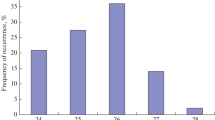Abstract
In the laboratory, courtship behavior and carotenoid pigmentation of male guppies are condition-dependent traits, since their expression is affected by physical vigor and environmental factors such as water velocity and diet. Whether these relationships exist in guppies under field conditions is yet to be determined. We compared the swimming performance, courtship behavior, and carotenoid pigmentation of guppies from headwater and downstream localities in four rivers of Trinidad. Swimming performance and courtship behavior of males differed among rivers and between headwater and downstream sites. Guppies from headwater sites swam significantly faster and had higher display rates than those from downstream sites. Mean swimming performance across sites was positively correlated with mean water velocity, but was correlated with the number of orange color spots (carotenoid pigment) in only one river. These results indicate that the courtship behavior of Trinidadian guppies is condition-dependent because the amount of display behavior is positively correlated to swimming performance, a measure of physical endurance. The proximal cause for this condition-dependence may be predator induced variation in microhabitat use by guppies in headwater and downstream locations.
Similar content being viewed by others
References cited
Andersson, M.B. 1994. Sexual selection. Princeton University Press, Princeton. 599 pp.
Baerends, G.P., R. Brouwer & H.T. Waterbolk. 1955. Ethological studies on Lebistes reticulatus (Peters). Behaviour 8: 249-335.
Beamish, F.W.H. 1978. Swimming capacity. pp. 101-187. In: W.S. Hoar & D.J. Randall (ed.) Fish Physiology, Vol. 7, Academic Press, New York.
Brett, J.R. 1964. The respiratory metabolism and swimming performance of young sockeye salmon. J. Fish. Res. Board Can. 21: 1183-1226.
Brett, J.R. & N.R. Glass. 1973. Metabolic rates and critical swimming speeds of sockeye salmon (Oncorhynchus nerka) in relation to size and temperature. J. Fish. Res. Board Can. 30: 379-387.
Björnsson, B. 1993. Swimming speed and swimming metabolism of Atlantic cod (Gadus morhua) in relation to available food: a laboratory study. Can. J. Fish. Aquat. Sci. 50: 2542-2551.
Buchholz, R. 1995. Female choice and male ornamentation in wild turkeys. Anim. Behav. 50: 929-943.
Burrows, R.E. 1969. The influence of fingerling quality on adult salmon survivals. Trans. Amer. Fish. Soc. 98: 777-784.
Byers, J.A., J.D. Moodie & N. Hall. 1994. Pronghorn females choose vigorous mates. Anim. Behav. 47: 33-43.
Clark, E. & R.L. Aronson. 1951. Sexual behavior in the guppy, Lebistes reticulatus (Peters). Zoologica 36: 49-66.
Conover, W.J. & R.L. Iman. 1981. Rank transformations as a bridge between parametric and nonparametric statistics. Am. Stat. 35: 124-129.
Cresswell, R.C. & R. Williams. 1983. Post-stocking movements and recapture of hatchery-reared trout released into flowing waters — effect of prior acclimation to flow. J. Fish Biol. 23: 265-276.
Dussault, G.V. & D.L. Kramer. 1981. Food and feeding behaviour of the guppy Poecilia reticulata (Pisces: Poeciliidae). Can. J. Zool. 59: 684-701.
Endler, J.A. 1978. A predator's view of animal color patterns. Evol. Biol. 11: 319-364.
Endler, J.A. 1983. Natural and sexual selection on color patterns in poeciliid fishes. Env. Biol. Fish. 9: 173-190.
Endler, J.A. 1987. Predation, light intensity, and courtship behavior in Poecilia reticulata (Pisces: Poeciliidae). Anim. Behav. 35: 1376-1385.
Endler, J.A. 1991. Variation in the appearance of guppy color patterns to guppies and their predators under different visual conditions. Vision Res. 31: 587-608.
Endler, J.A. 1992. Signals, signal conditions, and the direction of evolution. Amer. Nat. 139: 125-153.
Endler, J.A. 1995. Multiple trait coevolution and environmental gradients in guppies. TREE 10: 22-29.
Endler, J.A. & A.E. Houde. 1995. Geographic variation in female preferences for male traits in Poecilia reticulata. Evolution 49: 456-468.
Farr, J.A. 1980. Social behavior patterns as determinants of reproductive success in the guppy, Poecilia reticulata Peters (Pisces: Poeciliidae) — an experimental study of the effects of intermale competition, female choice, and sexual selection. Behavior 74: 38-91.
Haskins, C.P. & E.F. Haskins, J.J.A. McLaughlin & R.E. Hewitt. 1961. Polymorphism and population structure in Lebistes reticulatus, a population study. pp. 320-395. In: W.F. Blair (ed.) Vertebrate Speciation, University of Texas Press, Austin.
Hill, G.E. 1990. Female house finches prefer colourful males: sexual selection for a condition dependent trait. Anim. Behav. 40: 563-572.
Kodric-Brown, A. 1989. Dietary carotenoids and male mating success in the guppy: an environmental component to female choice. Behav. Ecol. Sociobiol. 25: 393-401.
Kodric-Brown, A. 1993. Female choice of multiple male criteria in guppies: interacting effects of dominance, coloration and courtship. Behav. Ecol. Sociobiol. 32: 415-420.
Kodric-Brown, A. & J.H. Brown. 1984. Truth in advertising: the kinds of traits favored by sexual selection. Amer. Nat. 124: 309-323.
Liley, N.R. 1966. Ethological isolating mechanisms in four sympatric species of poeciliid fishes. Behaviour (Suppl.) 13: 1-197.
Luyten, P.H. & N.R. Liley. 1985. Geographic variation in the sexual behavior of the guppy, Poecilia reticulata (Peters). Behavior 95: 164-179.
Luyten, P.H. & N.R. Liley. 1991. Sexual selection and competitive mating success of male guppies (Poecilia reticulata) from four Trinidad populations. Behav. Ecol. Sociobiol. 28: 329-336.
Magurran, A.E. & B.H. Seghers. 1994. Sexual conflict as a consequence of ecology: evidence from guppy, Poecilia reticulata, populations in Trinidad. Proc. R. Soc. Lond. B 255: 31-36.
Magurran, A.E., B.H. Seghers, G.R. Carvalho & P.W. Shaw. 1993. Evolution of adaptive variation in antipredator behavior. Mar. Behav. Physiol. 23: 29-44.
Møller, A.P. 1990. Parasites and sexual selection: current status of the Hamilton and Zuk hypothesis. J. Evol. Biol. 3: 319-328.
Nicoletto, P.F. 1991. The relationship between male ornamentation and swimming performance in the guppy, Poecilia reticulata. Behav. Ecol. Sociobiol. 28: 365-370.
Nicoletto, P.F. 1993. Female sexual response to condition-dependent ornaments in the guppy, Poecilia reticulata. Anim. Behav. 46: 441-450.
Nicoletto, P.F. 1996. The influence of water velocity on the display behavior of male guppies, Poecilia reticulata. Behav. Ecol. 7: 272-278.
Pomiankowski, A.N. 1987. The costs of choice in sexual selection. J. Theor. Biol. 128: 195-218.
Reznick, D.N. & J.A. Endler. 1982. The impact of predation on life history evolution in Trinidadian guppies. Evolution 36: 160-177.
Reznick, D.N., M.J. Butler, F.H. Rodd & P. Ross. 1996. Life-history evolution in guppies (Poecilia reticulata). Differential mortality as a mechanism for natural selection. Evolution 50: 1651-1660.
Robins, C. & R.W. Crawford. 1954. A short accurate method for estimating the volume of stream flow. J. Wildl. Manag. 18: 363-369.
Searcy, W.A. 1982. The evolutionary effects of mate selection. Ann. Rev. Ecol. Syst. 13: 57-58.
Seghers, B.H. 1974. Geographic variation in the response of guppies (Poecilia reticulata) to aerial predators. Oecologia 14: 93-98.
Smit, H. 1965. Some experiments on the oxygen consumption of goldfish (Carassius auratus L.) in relation to swimming speed. Can. J. Zool. 43: 623-633.
Taylor, E.B. & J.D. McPhail. 1986. Prolonged and burst swimming in anadromous and freshwater threespine stickleback, Gasterosteus aculeatus. Can. J. Zool. 64: 416-420.
Trivers, R.L. 1972. Parental investment and sexual selection. pp. 136-179. In: B. Campbell (ed.) Sexual Selection and the Descent of Man, Aldine Pub. Co., Chicago.
Webb, P.W. 1975. Hydrodynamics and energetics of fish propulsion. Bull. Fish. Res. Board. Can. 190: 1-59.
West-Eberhard, M.J. 1983. Sexual selection, social competition, and speciation. Quart. Rev. Biol. 58: 155-183.
Winemiller, K.O., M. Leslie & R. Roche. 1990. Phenotypic variation in male guppies from natural inland populations: an additional test of Haskins' sexual selection/predation hypothesis. Env. Biol. Fish. 29: 179-191.
Zahavi, A. 1975. Mate selection — a selection for a handicap. J. Theor. Biol. 53: 205-214.
Zuk, M. 1991. Sexual ornaments as animal signals. TREE 6: 228-231.
Author information
Authors and Affiliations
Rights and permissions
About this article
Cite this article
Nicoletto, P.F., Kodric-Brown, A. The Relationship Among Swimming Performance, Courtship Behavior, and Carotenoid Pigmentation of Guppies in Four Rivers of Trinidad. Environmental Biology of Fishes 55, 227–235 (1999). https://doi.org/10.1023/A:1007587809618
Issue Date:
DOI: https://doi.org/10.1023/A:1007587809618




